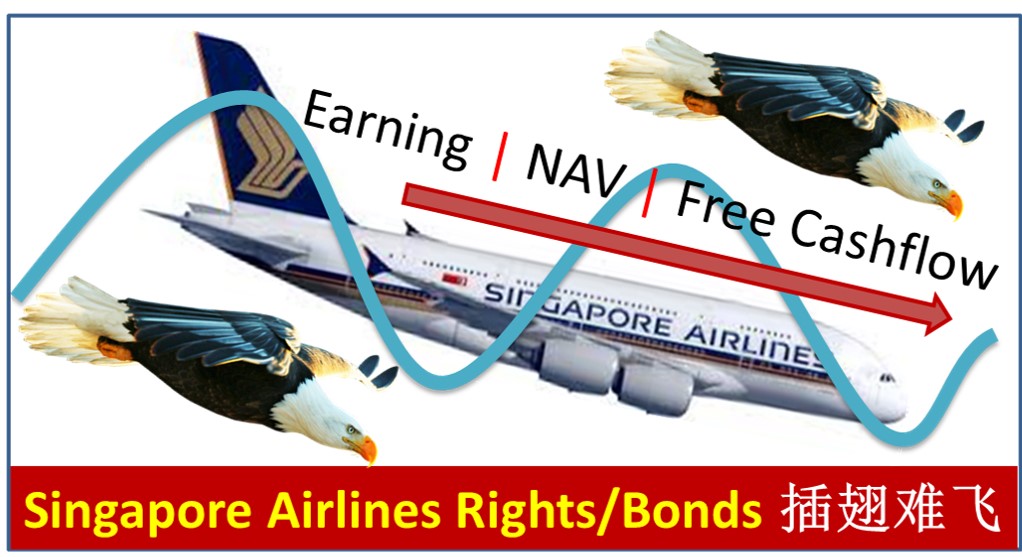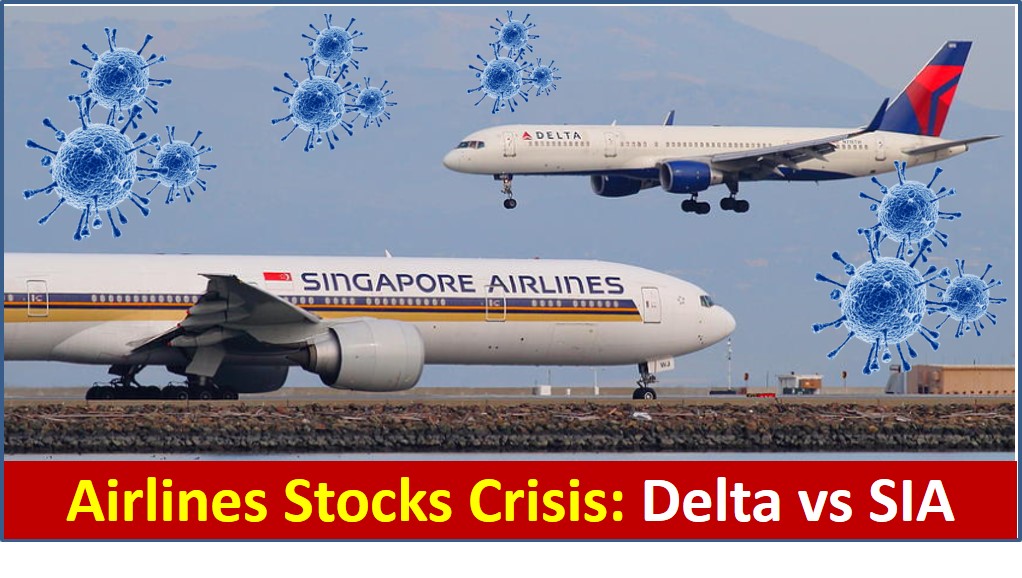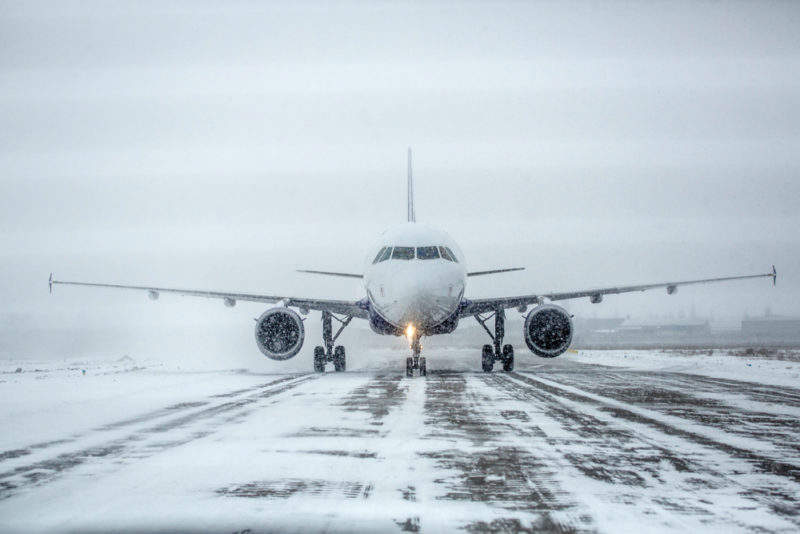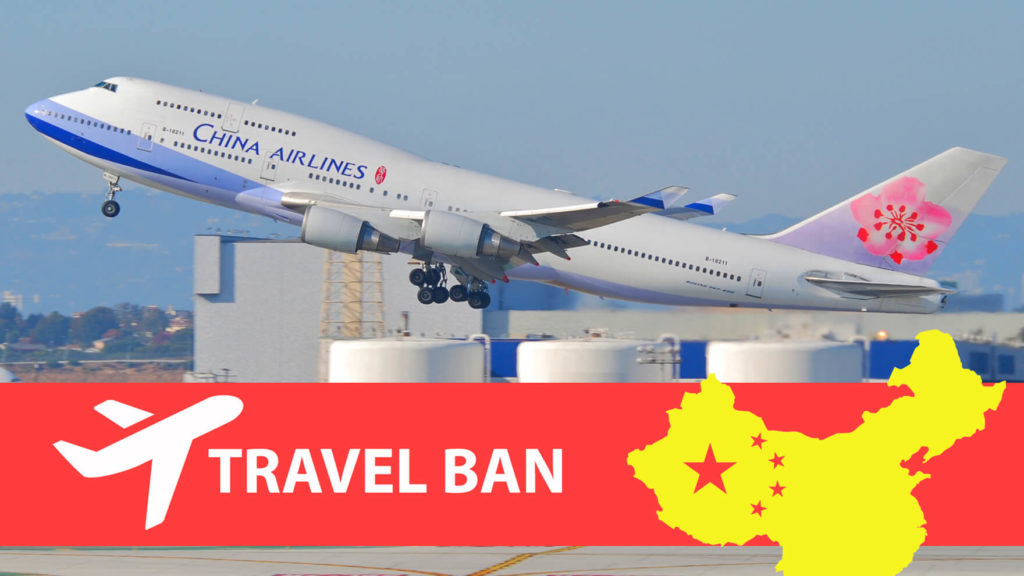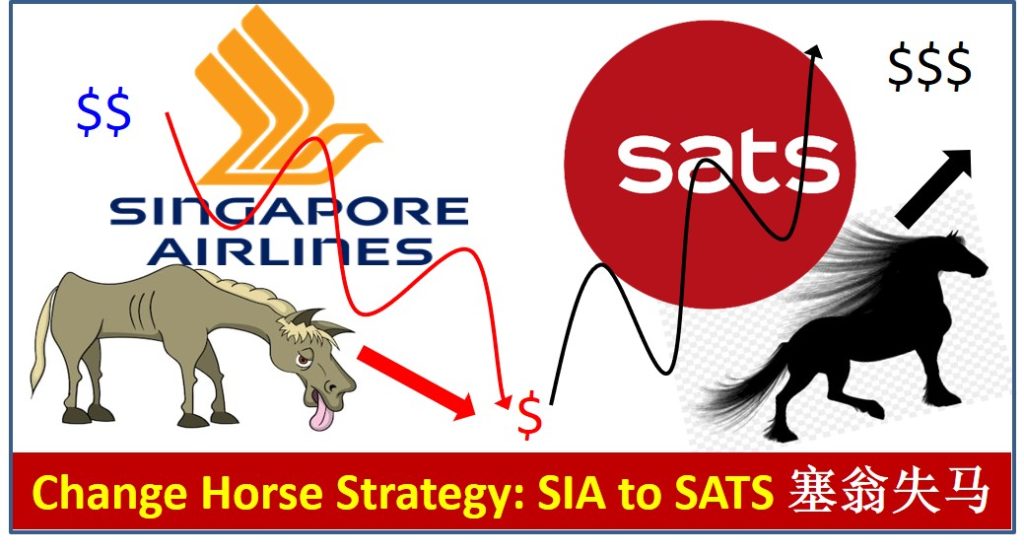
Nightmare of a long term investor is to hold on to a weak fundamental stock with declining share prices over the decade, wasting both time and capital. It is painful to cut loss halfway, therefore many retail traders (especially those who follow tips to invest) may initially plan for short term trading but when encountering global stock crisis falling from high stock optimism, making losses, forced to be a long term investor since then.
Singapore Airlines (SGX: C6L), SIA, is not a giant stock nor junk stock, under-performing in business (see details of SIA stock in another earlier post), both long term investors (hold for 10 years) or short term traders (hold for 1 month) may make significant losses. So, some investors may be mentally conditioned (despite having option) to subscribe to new rights and bonds issues to avoid future share dilution, investing more new capitals in unknown future of SIA in competitive airlines industry.
Many people may think big names (especially blue chip stocks with decades of history) equals to strong companies. SIA is a big reputable company, therefore some may think it is also a good stock investment, especially backed by Temasek, 55% major shareholder.
There are at least 26 Temasek / GLC stocks in Singapore including Singapore Airlines and SATS, controlling shareholder with 15% or more ownership directly or indirectly (investor needs to focus only on giant Temasek stocks):
Singtel (SGX: Z74), DBS Bank (SGX: D05), ST Engineering (SGX: S63), Singapore Airlines (SGX: C6L), SIA Engineering (SGX: S59), Singapore Exchange (SGX: S68), SATS (SGX: S58), Sembcorp Industries (SGX: U96), Sembcorp Marine (SGX: S51), Olam (SGX: O32), CapitaLand (SGX: C31), CapitaLand Mall Trust (SGX: C38U), CapitaLand Commercial Trust (SGX: C61U), Ascendas Reit (SGX: A17U), Ascott Hospitality Trust (SGX: HMN), Ascendas Hospitality Trust (SGX: Q1P), CapitaLand Retail China Trust (SGX: AU8U), Ascendas-iTrust (SGX: CY6U), Keppel Corp (SGX: BN4), Keppel Reit (SGX: K71U), Keppel DC Reit (SGX: AJBU), Keppel Infrastructure Trust (SGX: A7RU), Mapletree Logistics Trust (SGX: M44U), Mapletree Commercial Trust (SGX: N2IU), Mapletree Industrial Trust (SGX: ME8U), Mapletree NAC Trust (SGX: RW0U).
Temasek stocks portfolio also affect about 15% of STI index stocks, which has strong impact on Singapore stock market. Here are 30 STI component stocks:
DBS Bank (SGX: D05), Singtel (SGX: Z74), OCBC Bank (SGX: O39), UOB Bank (SGX: U11), Wilmar International (SGX: F34), Jardine Matheson Holdings JMH (SGX: J36), Jardine Strategic Holdings JSH (SGX: J37), Thai Beverage (SGX: Y92), CapitaLand (SGX: C31), Ascendas Reit (SGX: A17U), Singapore Airlines (SGX: C6L), ST Engineering (SGX: S63), Keppel Corp (SGX: BN4), Singapore Exchange (SGX: S68), HongkongLand (SGX: H78), Genting Singapore (SGX: G13), Mapletree Logistics Trust (SGX: M44U), Jardine Cycle & Carriage (SGX: C07), Mapletree Industrial Trust (SGX: ME8U), City Development (SGX: C09), CapitaLand Mall Trust (SGX: C38U), CapitaLand Commercial Trust (SGX: C61U), Mapletree Commercial Trust (SGX: N2IU), Dairy Farm International (SGX: D01), UOL (SGX: U14), Venture Corporation (SGX: V03), YZJ Shipbldg SGD (SGX: BS6), Sembcorp Industries (SGX: U96), SATS (SGX: S58), ComfortDelGro (SGX: C52).
We may study Temasek portfolio (about 40 global stocks, about half are giant stocks, half are non-giant stocks, based on Ein55 giant criteria), focusing on top 10 Temasek giant stocks, buying them at low optimism prices (could be lower than Temasek’s entry price for some stocks now), selling them at high optimism prices in future, protected by Temasek (eg. even for non-giant stocks: Olam, SIA, etc).
Temasek has a giant stock, SATS (SGX: S58), spinoff from SIA many years ago. Although both SATS and SIA are low optimism stocks (both related to airlines industry, suffering in Coronavirus crisis), SATS is a much better opportunity than SIA to buy at low optimism.
SATS controls about 80% of Changi Airport’s ground handling and catering business. SATS has 2 main businesses (about half each), gateway services and food catering services (including to non-airlines sectors). Similar to SIA, SATS is also affected by airlines sector crisis due to Coronavirus spreading, over 90% flights are down, business will be affected in next 12 months. However, in a longer term, SATS has 2 times stronger business fundamental than SIA. The performances of 3 key financial statements over the past decade are exactly opposite for SATS and SIA:
Income Statement:
SATS = increasing earnings
SIA = declining earnings
Balance Sheet:
SATS = increasing equity, declining debt / equity
SIA = declining equity, increasing debt / equity
Cashflow Statement:
SATS = increasing free cashflow
SIA = declining free cashflow
At current share prices, SIA is about 4.9% dividend yield (potential value trap, crisis is crisis), SATS is 5.6% dividend yield (crisis is opportunity).
For SIA investor who holds to SIA stocks with losses but could not sell due to loss aversion, may sell SIA and buy SATS on the same day with same capital remaining (fine even if 50% loss), transferring the fund (soul) from a old horse (SIA) to a young horse (SATS) which has a brighter future and strong energy than SIA to climb higher for capital gains in long term.
This is Dr Tee (Ein55) powerful “Change Horse” Strategy, suitable for those “stubborn” long term investors holding losing stocks for many years. This is a strong Personal Analysis (PA) method as an investor could tell husband or wife that they never actually sell the stock (eg. SIA), just change the stock name to SATS, offspring of SIA. This is important for those who assume sell a losing weaker stock implies immediate loss, they could continue to hold the stock but through transfer of capital to another giant stock, future winning probability would be higher than continue with than the weak stock (may be worse if double the investment with average cost strategy with new rights).
SIA vs SATS may not be the best example to illustrate “Change Horse” strategy because SIA is not a junk stock and SATS is a giant stock but suffering Level 2 (sector) crisis of airlines industry. This strategy will be even more powerful if readers could apply changing a junk stock with a strong giant stock in a promising sector (low optimism in stock prices but not having crisis in business or sector).
A mistake (eg. making losses in stock investing) is not a mistake if one could learn from the mistake, not too late, even knowing after this article. It is a blessing in disguise(塞翁失马、焉知非福)if an investor could learn to overcome own biggest enemy (oneself) to change a weak stock with a giant stock immediately. SATS may not be the best example to “change horse” as there are over 1500+ global giant stocks based on Ein55 giant stock criteria, one may select 10 giant stocks aligned with own unique personality to form a dream team stock portfolio.
==================================
Drop by Dr Tee free 4hr investment course to learn how to position in global giant stocks with 10 unique stock investing strategies, knowing What to Buy, When to Buy/Sell.
Learn further from Dr Tee valuable 7hr Online Course, both English (How to Discover Giant Stocks) and Chinese (价值投资法: 探测强巨股) options, specially for learners who prefer to master stock investment strategies of over 100 global giant stocks at the comfort of home.
You are invited to join Dr Tee private investment forum (educational platform, no commercial is allowed) to learn more investment knowledge, interacting with over 9000 members.

